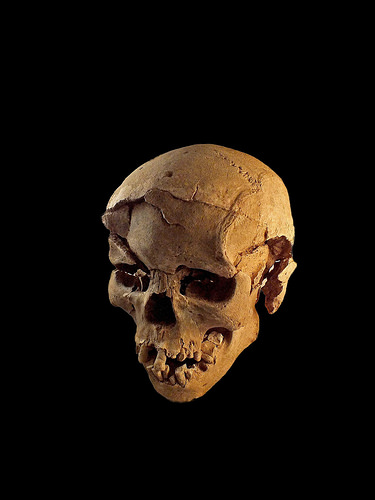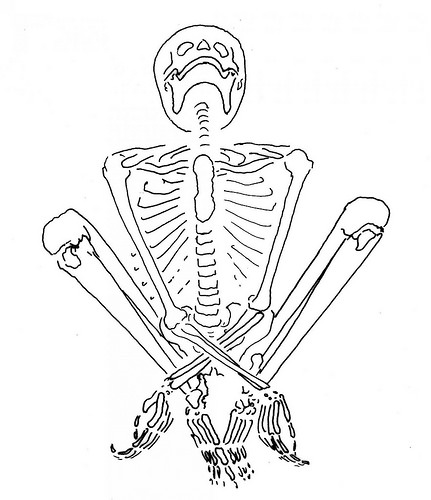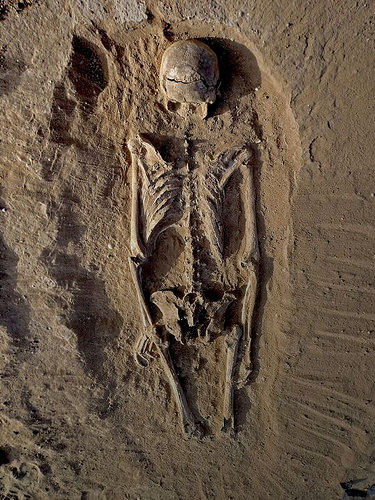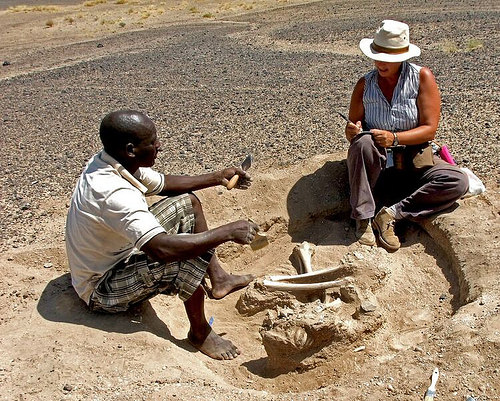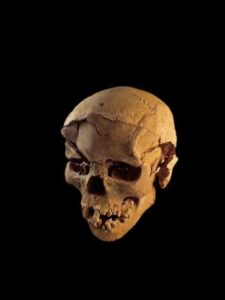
UNIVERSITY OF CAMBRIDGE—The fossilised bones of a group of prehistoric hunter-gatherers who were massacred around 10,000 years ago have been unearthed 30km west of Lake Turkana, Kenya, at a place called Nataruk.
Researchers from Cambridge University’s Leverhulme Centre for Human Evolutionary Studies found the partial remains of 27 individuals, including at least eight women and six children.
Twelve skeletons were in a relatively complete state, and ten of these showed clear signs of a violent death: including extreme blunt-force trauma to crania and cheekbones, broken hands, knees and ribs, arrow lesions to the neck, and stone projectile tips lodged in the skull and thorax of two men.
Several of the skeletons were found face down; most had severe cranial fractures. Among the in situ skeletons, at least five showed “sharp-force trauma”, some suggestive of arrow wounds. Four were discovered in a position indicating their hands had probably been bound, including a woman in the last stages of pregnancy. Foetal bones were uncovered.
The bodies were not buried. Some had fallen into a lagoon that has long since dried; the bones preserved in sediment.
The findings suggest these hunter-gatherers, perhaps members of an extended family, were attacked and killed by a rival group of prehistoric foragers. Researchers believe it is the earliest scientifically-dated historical evidence of human conflict – an ancient precursor to what we call warfare.
The origins of warfare are controversial: whether the capacity for organised violence occurs deep in the evolutionary history of our species, or is a symptom of the idea of ownership that came with the settling of land and agriculture.
The Nataruk massacre is the earliest record of inter-group violence among prehistoric hunter-gatherers who remained largely nomadic.
“The deaths at Nataruk are testimony to the antiquity of inter-group violence and war,” said Dr Marta Mirazon Lahr, from Cambridge’s LCHES, who directs the IN-AFRICA Project and led the Nataruk study, published today in the journal Nature.
“These human remains record the intentional killing of a small band of foragers with no deliberate burial, and provide unique evidence that warfare was part of the repertoire of inter-group relations among some prehistoric hunter-gatherers,” she said.
The site was first discovered in 2012. Following careful excavation, the researchers used radiocarbon and other dating techniques on the skeletons – as well as on samples of shell and sediment surrounding the remains – to place Nataruk in time. They estimate the event occurred between 9,500 to 10,500 years ago, around the start of the Holocene: the geological epoch that followed the last Ice Age.
Now scrubland, 10,000 years ago the area around Nataruk was a fertile lakeshore sustaining a substantial population of hunter-gatherers. The site would have been the edge of a lagoon near the shores of a much larger Lake Turkana, likely covered in marshland and bordered by forest and wooded corridors.
This lagoon-side location may have been an ideal place for prehistoric foragers to inhabit, with easy access to drinking water and fishing – and consequently, perhaps, a location coveted by others. The presence of pottery suggests the storage of foraged food occurred.
“The Nataruk massacre may have resulted from an attempt to seize resources – territory, women, children, food stored in pots – whose value was similar to those of later food-producing agricultural societies, among whom violent attacks on settlements became part of life,” said Mirazon Lahr.
“This would extend the history of the same underlying socio-economic conditions that characterise other instances of early warfare: a more settled, materially richer way of life. However, Nataruk may simply be evidence of a standard antagonistic response to an encounter between two social groups at that time.”
Antagonism between hunter-gatherer groups in recent history often resulted in men being killed, with women and children subsumed into the victorious group. At Nataruk, however, it seems few, if any, were spared.
Of the 27 individuals recorded, 21 were adults: eight males, eight females, and five unknown. Partial remains of six children were found co-mingled or in close proximity to the remains of four adult women and of two fragmentary adults of unknown sex.
No children were found near or with any of the men. All except one of the juvenile remains are children under the age of six; the exception is a young teenager, aged 12-15 years dentally, but whose bones are noticeably small for his or her age.
Ten skeletons show evidence of major lesions likely to have been immediately lethal. As well as five – possibly six – cases of trauma associated with arrow wounds, five cases of extreme blunt-force to the head can be seen, possibly caused by a wooden club. Other recorded traumas include fractured knees, hands and ribs.
Three artefacts were found within two of the bodies, likely the remains of arrow or spear tips. Two of these are made from obsidian: a black volcanic rock easily worked to razor-like sharpness. “Obsidian is rare in other late Stone Age sites of this area in West Turkana, which may suggest that the two groups confronted at Nataruk had different home ranges,” said Mirazon Lahr.
One adult male skeleton had an obsidian ‘bladelet’ still embedded in his skull. It didn’t perforate the bone, but another lesion suggests a second weapon did, crushing the entire right-front part of the head and face. “The man appears to have been hit in the head by at least two projectiles and in the knees by a blunt instrument, falling face down into the lagoon’s shallow water,” said Mirazon Lahr.
Another adult male took two blows to the head – one above the right eye, the other on the left side of the skull – both crushing his skull at the point of impact, causing it to crack in different directions.
The remains of a six-to-nine month-old fetus were recovered from within the abdominal cavity of one of the women, who was discovered in an unusual sitting position – her broken knees protruding from the earth were all Mirazon Lahr and colleagues could see when they found her. The position of the body suggests that her hands and feet may have been bound.
____________________________________________
This skeleton was that of a man, found lying prone in the lagoon’s sediments. The skull has multiple lesions on the front and on the left side, consistent with wounds from a blunt implement, such as a club. Credit: Marta Mirazon Lahr
____________________________________________
This skeleton was that of a young woman, who was pregnant at the time of her death. She was found in a sitting position, with the hands crossed between her legs. The position of the body suggests that the hands and feet may have been bound. Credit: Illustration by Marta Mirazon Lahr
______________________________________________________
Skeleton KNM-WT 71255 after excavation. This skeleton was that of a man, found lying prone in the lagoon’s sediments. The skull has multiple lesions on the front and on the left side, consistent with wounds from a blunt implement, such as a club. Image by Marta Mirazon Lahr, enhanced by Fabio Lahr
__________________________________________________________
Photograph of Dr Marta Mirazon Lahr and Justus Edung at the end of the excavation of the skeleton KNM-WT 71259. This skeleton was that of a woman, found reclining on her left elbow, with fractures on the knees and possibly the left foot. The position of the hands suggests her wrists may have been bound. She was found surrounded by fish. Image by Robert Foley
______________________________________________________
While we will never know why these people were so violently killed, Nataruk is one of the clearest cases of inter-group violence among prehistoric hunter-gatherers, says Mirazon Lahr, and evidence for the presence of small-scale warfare among foraging societies.
For study co-author Professor Robert Foley, also from Cambridge’s LCHES, the findings at Nataruk are an echo of human violence as ancient, perhaps, as the altruism that has led us to be the most cooperative species on the planet.
“I’ve no doubt it is in our biology to be aggressive and lethal, just as it is to be deeply caring and loving. A lot of what we understand about human evolutionary biology suggests these are two sides of the same coin,” Foley said.
Source: University of Cambridge news release.
____________________________________________
In addition, the latest Popular Archaeology ebook is now available.
______________________________________________
Travel and learn with Far Horizons.
____________________________________________
This richly illustrated issue includes the following stories: Two remarkable discoveries that are shedding light on human beginnings in Africa; a traveling exhibit and an archaeological site that show how knowledge is more valuable than gold; a Spanish cave and a unique burial that are offering a tantalizing glimpse on the lives of Ice Age hunter-gatherers in Europe; the stunning visual reconstruction of an ancient Roman town; enlightening new finds at a remarkably well-preserved site of ancient Hellenistic-Roman culture overlooking the Sea of Galilee; rare finds that are shedding light on occult practices among ancient Greeks in Sicily; and an overview of the overwhelmingly rich archaeological heritage of Britain. Find it on Amazon.com.

